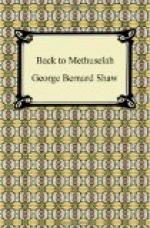Creative Evolution is already a religion, and is indeed now unmistakeably the religion of the twentieth century, newly arisen from the ashes of pseudo-Christianity, of mere scepticism, and of the soulless affirmations and blind negations of the Mechanists and Neo-Darwinians. But it cannot become a popular religion until it has its legends, its parables, its miracles. And when I say popular I do not mean apprehensible by villagers only. I mean apprehensible by Cabinet Ministers as well. It is unreasonable to look to the professional politician and administrator for light and leading in religion. He is neither a philosopher nor a prophet: if he were, he would be philosophizing and prophesying, and not neglecting both for the drudgery of practical government. Socrates and Coleridge did not remain soldiers, nor could John Stuart Mill remain the representative of Westminster in the House of Commons even when he was willing. The Westminster electors admired Mill for telling them that much of the difficulty of dealing with them arose from their being inveterate liars. But they would not vote a second time for the man who was not afraid to break the crust of mendacity on which they were all dancing; for it seemed to them that there was a volcanic abyss beneath, not having his philosophic conviction that the truth is the solidest standing ground in the end. Your front bench man will always be an exploiter of the popular religion or irreligion. Not being an expert, he must take it as he finds it; and before he can take it, he must have been told stories about it in his childhood and had before him all his life an elaborate iconography of it produced by writers, painters, sculptors, temple architects, and artists of all the higher sorts. Even if, as sometimes happens, he is a bit of an amateur in metaphysics as well as a professional politician, he must still govern according to the popular iconography, and not according to his own personal interpretations if these happen to be heterodox.
It will be seen then that the revival of religion on a scientific basis does not mean the death of art, but a glorious rebirth of it. Indeed art has never been great when it was not providing an iconography for a live religion. And it has never been quite contemptible except when imitating the iconography after the religion had become a superstition. Italian painting from Giotto to Carpaccio is all religious painting; and it moves us deeply and has real greatness. Compare with it the attempts of our painters a century ago to achieve the effects of the old masters by imitation when they should have been illustrating a faith of their own. Contemplate, if you can bear it, the dull daubs of Hilton and Haydon, who knew so much more about drawing and scumbling and glazing and perspective and anatomy and ‘marvellous foreshortening’ than Giotto, the latchet of whose shoe they were nevertheless not worthy to unloose. Compare Mozart’s Magic Flute, Beethoven’s Ninth Symphony, Wagner’s




